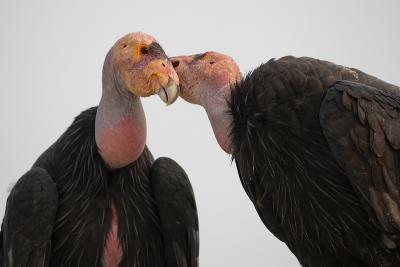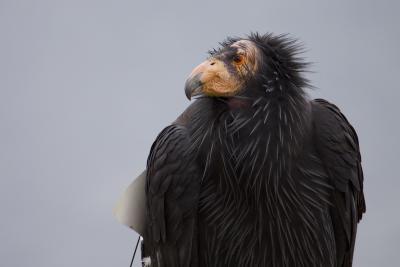In one sense the story of the California condor is a great triumph.
At one point, the number of free-flying condors in their namesake state had dropped to zero. But by 2010, after decades of restoration efforts, the population resurged to a milestone figure: one hundred birds soaring through California’s skies. Condors had begun to lay eggs in Mexico, too, for the first time since at least the 1930s. And when a pair of condors nested in Big Sur, they were the first to do so in northern California in a century.
But then there’s this: Every success for the condor has been accompanied by some grim new news. Inland, lead bullets are poisoning these birds. On the coast, meanwhile, condors are hit by the effects of a decades-old insecticide. Is there anywhere safe for these birds?
That’s what a team of researchers funded by California Sea Grant has been trying to determine. In an ecological detective story that weaves together several strands of innovative science, they have identified a new potential homeland for the birds: the Mexican state of Baja California.
A precarious bird
In more ancient eras, the California condor might have merited a different name: these raptors roamed all of North America, from Canada to Mexico, from Florida to New York. This expansive reign ended around ten thousand years ago, when — for reasons that remain hotly debated — the continents’ large mammals, such as mammoths and sabertooth tigers, mostly went extinct. By the time European settlers arrived in North America, California condors were limited to a thin strand of land along the Pacific coast.
The arrival of Europeans in North America unleashed changes that all but wiped out these remaining condors. New towns and cities and farms chipped away at their habitat. Wildlife agencies trying to control predators such as wolves and coyotes accidentally poisoned the birds. But one of the most pressing problems for condors was highlighted in Rachel Carson’s influential book Silent Spring: certain chemicals interfere with birds’ endocrine systems, causing mothers to lay eggs with too-thin shells. Dichlorodiphenyltrichloroethane, or DDT, was a particular problem, as were chemicals created as DDT morphed into new forms as the animal metabolized it.

Though the use of DDT was outlawed in 1972, the other threats lingered. A decade later, just 22 condors were left in the wild.
Happily, this is where the story turns around: The next year, the U.S. Fish and Wildlife Service gathered up the remaining birds and launched a captive breeding program. By 1992, biologists were able to reintroduce condors back into the California landscape, and eventually in Utah and Arizona, too. These days, around 500 condors live in the U.S., nearly half outside of captivity.
Continued Troubles
But the birds are still under threat — so much so that the wild population is still not self-sustaining. The biggest problem is lead poisoning. Hunters often shoot game with lead bullets, then abandon the carrion. When inland condors feed on it, the lead that they swallow kills the birds.
In comparison, California’s coast was long seen as a safer place for condors, since here the birds mostly eat the carcasses of beached sea mammals that generally aren’t tainted by bullets. This accepted wisdom was challenged in the 2010s, though, when researchers examining eggs collected in Big Sur found the shells were a third thinner than eggs from inland birds. Alarmed, biologists began to collect the weak eggs to be incubated, leaving in their place stronger-shelled eggs laid by captive birds.
The thinning of the shells was nearly identical to that seen forty years earlier, when DDT was being actively sprayed. And, in fact, the pesticide is still to blame. “DDT is such a persistent chemical,” says Christopher Tubbs, an endocrinologist at the San Diego Zoo Wildlife Alliance. In soil, DDT’s half-life in soil can be as long as 15 years. In water — home to many of the animals live that the condors eventually end up eating — the half-life can be ten times longer. “DDT is still present, and still doing pretty bad things to wildlife,” says Tubbs, who studies how such chemicals impact animals, including condors.
Given their endangered status, this is not an easy task. “We don't want to treat animals with chemicals and watch what happens,” he says. Instead, Tubbs uses tissues collected from dead condors, then clones condor estrogen receptor proteins and exposes them to contaminants to study the effects.
Tubbs can only test chemicals he knows are in the environment. As of a decade ago, the standard practice was to identify a few potential pollutants in an environment, and then look for them in samples, using techniques such as mass spectrometry.
A chemical search
The method has a key drawback.
“If unknown chemicals are present, it cannot detect them,” says San Diego State University environmental health researcher Eunha Hoh. Since we often know little about the chemicals that our industrial processes produce, this standard approach can leave glaring holes.
Hoh’s first job after her master’s degree in chemistry was for a major electronics manufacturer. She often found herself standing before wastewater pipes gushing with toxic chemicals. The experience drove Hoh back to academia. As a doctoral student at Indiana University, she discovered a never-before-identified flame retardant in the atmosphere. This experience led her to develop a new method, known as “non-targeted analysis” (NTA) as a postdoctoral researcher at the U.S. Department of Agriculture and as a faculty in San Diego State University. It allowed scientists to look at samples and detect the signatures of previously unconsidered chemicals. “We’re looking without a hypothesis, to what’s there,” she explains.
Later, Hoh implemented the method to investigate the blubber of dolphins that washed up, dead, in Southern California. As the top predators in the ocean, dolphins serve as an effective archive of contaminants that have been consumed down the food chain.
What Hoh found was alarming: the dolphins carried 45 compounds related to DDT, the vast majority of which are not typically sought in chemical monitoring, she noted in a 2016 paper. In another paper, she looked at Brazilian dolphins. Comparatively, the amount of such compounds in California dolphins was shockingly high.
The problem is so pronounced in California because a major DDT production facility operated in Los Angeles for many years — for a decade after domestic use of the chemical was banned, even, since the chemical was still used overseas. The factory dealt with its waste products by sealing them in barrels, then dropping them into the ocean. Perhaps a half-million barrels were disposed this way, some hacked open with axes to ensure that they’d sink.
Because of this, “our ocean is so much more polluted with DDT [than other places]. We cannot just say, ‘That’s done; we can move on to other things,’” Hoh told the Los Angeles Times, in 2020.
Connecting the scientific dots
Hoh and Tubbs were looking at the same problem from different angles, then. Their paths collided thanks to an ambitious student in Hoh’s laboratory named Jennifer Cosaboon, who decided to volunteer at the San Diego Zoo.

“When she told me, I was concerned – like, ‘Jenn, you should focus on your work, because you’re doing too much,’” Hoh remembers. “She convinced me she could do both. And she did!”
At the zoo, Cossaboon wound up working with Tubbs. She linked her two mentors together. “We’ve been collaborating ever since,” Tubbs says.
A paper in Environmental Science & Technology in 2022 described how the researchers together assessed the risks to California condors, combining their two unique skill sets. The work was funded by California Sea Grant.
Hoh studied condor plasma collected in the field by biologists in both California and from inland populations. As expected, given what was already known about dolphins, the concentration of some DDT derivatives was twenty times higher in the coastal condor plasma.
Tubbs, meanwhile, analyzed the effects of newly identified compounds on condors. He at least found a small bit of good news: these compounds had little impact on condor estrogen receptors, at least at the levels currently found in the environment.
A perfect home?
The two scientists also researched how those majestic birds might fare further south. Reintroduced condors have lived in the Mexican state of Baja California since 2002. For now, these birds mostly feed on supplied carcasses, plus occasional wild carrion. Eventually, as the flock grows and expands, the birds will begin feeding on marine mammals washing up from the Gulf of California. Will they face the same challenges as California’s birds?
To answer that question, Hoh compared blubber from dolphin carcasses collected in both regions. Mexican dolphins, she found, held far less DDT — seven times less than in California.
Preliminary results hint that the same might hold true for the condors. Tubbs and Hoh were eventually able to acquire condor plasma from Mexico, and Hoh has determined that their blood shows very low exposure to the DDT compounds. (This research has yet to be published.) Baja California, then, may be a little slice of paradise for these much-beleaguered birds.
This is a nice bit of news for the condors. But it should come with a lesson, Tubbs thinks. Humans used DDT because they thought the pesticide was beneficial in saving crops and preventing malaria. "But then you look at what it’s able to do for decades and decades — it’s kind of frightening. I look at all the packaging that food and snacks come in, and I’m like — ‘what are we doing here?’ It’s one of those things: you realize the impacts that humans can have on the environment.”